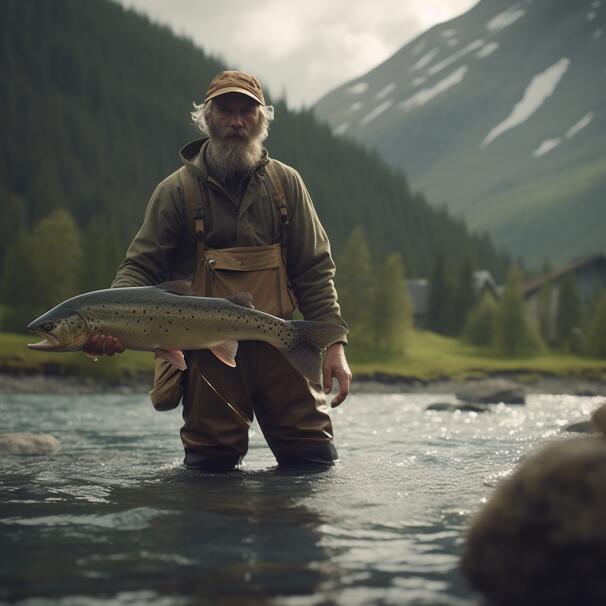
Table of contents
• Introduction
• Tips for choosing the right location
• Tips for selecting the right bait and tackle
• Tips for casting and setting up
• Tips for catching and releasing the fish
• Tips for safety and precaution
• Conclusion
Introduction
Trout fishing is a popular sport among fishing enthusiasts. It involves catching trout, a species of freshwater fish that are found in rivers, streams, and lakes. For many, trout fishing is not just about catching fish - it's a chance to spend time in nature, enjoy the scenery, and test their skills. To start with, one needs to have the right equipment, which includes a fishing rod, reel, line, lures or bait, and appropriate clothing for the weather condition. Trout fishing is exciting because it requires a certain level of patience and skill to catch a fish. It's not just a matter of dropping a line in the water and waiting for a fish to bite. With the right strategy and technique, catching trout can be an incredibly rewarding experience.
Tips for choosing the right location
Trout fishing is an enjoyable and rewarding activity, but choosing the right location can make or break your fishing experience. It's important to research the best fishing spots in your area, taking into consideration the type of water body and potential natural food sources.
Pro tip: Don't waste your time fishing in an area with little to no activity, or where the water is too murky. Instead, opt for clear water with signs of natural movement.
If you're fishing in a river, look for breaks in the current that provide cover for the trout. Keep in mind that trout prefer areas with an ample supply of food, so casting near vegetation or underwater structures can increase your odds of catching a fish.
Remember, finding the right location takes time and patience. Don't be afraid to venture out and try different spots until you find the one that works for you.
Tips for selecting the right bait and tackle
When it comes to selecting the right bait and tackle for trout fishing, there are a few key things to keep in mind.
First and foremost, it's important to understand the trout's diet. Different species of trout may have different preferences, so research what they typically eat in the area you'll be fishing in. Matching the bait to the water is also crucial.
For example, if the water is clear, use lighter and more natural-colored bait. On the other hand, if the water is murky, opt for brighter and more visible bait.
Lastly, select the right size hook based on the size of the trout you're targeting. Going too big or too small can decrease your chances of a successful catch. Remember, the right bait and tackle can make all the difference in your fishing experience!
Tips for casting and setting up
When it comes to trout fishing, mastering the art of casting is crucial. It takes time, practice and patience to get it right. However, it is worth the effort. Your casting technique can determine the success or failure of your fishing trip. Besides, consider the weather conditions of the day. The wind, water flow, and clarity can affect your casting and success. Hence, before setting up to cast, observe the surrounding elements that may pose a challenge.
Finally, set up your tackle correctly. A well-balanced setup that you can handle comfortably is essential. Otherwise, you may lose the trout due to a faulty tackle. Therefore, choose the right line, reel, and rod, and ensure they work together harmoniously. Mastering casting, considering weather, and setting up the tackle correctly are significant tips for catching trout worth remembering.
Tips for catching and releasing the fish
Trout fishing is not just about catching fish; it's about catching and releasing them with care. Here are some tips to help you do just that.
Firstly, wait for the right moment to set the hook. This might take some practice, but it's worth it. You don't want to pull too hard and hurt the fish or miss the opportunity altogether. Patience is key.
Secondly, be patient and persistent. Trout fishing can be challenging, so don't give up too easily. Keep trying different bait and techniques until you find what works.
And finally, release the fish with care. If you're going to catch and release, you need to do it properly. Avoid using a net, as it can damage the fish's gills and scales. Instead, gently hold the fish in the water while removing the hook. Once the fish starts to swim away, let it go.
Remember, responsible fishing is not just about catching fish; it's about respecting the environment and the fish we catch. With these tips, you can enjoy the sport of trout fishing while ensuring the fish are able to thrive in their natural habitat.
Tips for safety and precaution
Trout fishing can be an adventure, but safety should always come first. Don't forget to carry safety gear and follow local regulations to ensure a fun and safe fishing experience. Also, be careful while wading, as slippery rocks can cause accidents. Remember, a responsible angler not only catches fish but also takes care of their safety and the environment. Happy fishing!
Conclusion
Whether you're a seasoned angler or just starting out, trout fishing can be a thrilling experience. Remember to choose the right location, bait and tackle, and be patient when waiting for the right catch. It's also crucial to practice responsible fishing and release the fish with care. So go ahead and give trout fishing a shot, you might just find your new favourite hobby. Good luck, and happy fishing!

